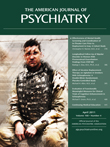T
o the E
ditor: Naltrexone is an opioid receptor antagonist approved by the Food and Drug Administration for alcohol and opioid dependence. Case reports have noted efficacy in impulse control disorders and self-injury, particularly in populations with developmental delay (
1). Newer research suggests that response to naltrexone may be predicted by elevated beta-endorphin levels following self-injurious behavior (
2). We report on a case of severe treatment-resistant self-mutilating behavior successfully treated with naltrexone.
“Ms. R” is a 32-year-old woman of normal intelligence with over 50 psychiatric hospitalizations in the past 8 years, most for cutting behavior deemed dangerous to self because of the quantity and severity of the wounds. She had a diagnosis of recurrent major depressive disorder superimposed on borderline personality disorder, with micro-psychotic episodes and poor impulse control. The patient had failed to benefit from multiple adequate trials with various combinations of antidepressants, atypical antipsychotics, conventional antipsychotics, mood stabilizers, benzodiazepines, alpha1 antagonists, intensive case management, and elements of dialectical behavioral therapy. We discussed with the patient the risks and the potential benefits of a trial of naltrexone to reduce her urges to cut. Liver function test results were mildly elevated from fatty liver secondary to metabolic syndrome. Other psychotropic medications were not changed. The patient was treated with naltrexone, 25 mg/day, titrated up to 50 mg after 1 month. Her medications were given by her home health nurses or her grandmother, and she was compliant with taking them.Ms. R noted decreased urges to cut after 1 week of treatment, with a reduced frequency of cutting behavior after her dosage was increased to 50 mg/day. The patient stated that she used to think about cutting “constantly” and would cut one to three times per day, but now will go “days” without thinking about it and only cut one to two times per week at most. After 5 months of continuous treatment, she had a 6-month period with only one superficial cutting episode. Liver function tests improved from baseline, with the exception of a 16-point increase in aspartate aminotransferase, which was stable over the course of several months.
This case highlights the potential efficacy of naltrexone in self-injurious behavior resistant to multiple psychopharmacological and behavioral interventions. Utilization of this treatment may allow for tapering or discontinuation of atypical antipsychotics and mood stabilizers that have significant metabolic side effects, including weight gain and diabetes. Although previous reports have described similar effects, the magnitude of the response, the medical comorbidities, and the resistance to treatment in this patient demonstrate a need to consider naltrexone sooner in treatment algorithms. Our group has also used naltrexone to treat an autistic man with sexually violent behavior and an elderly man with dementia and sexually inappropriate behavior, with resolution of symptoms and no adverse events. Large-scale randomized placebo-controlled trials are necessary to provide further evidence for the use of naltrexone in refractory cases of impulse control disorders.

